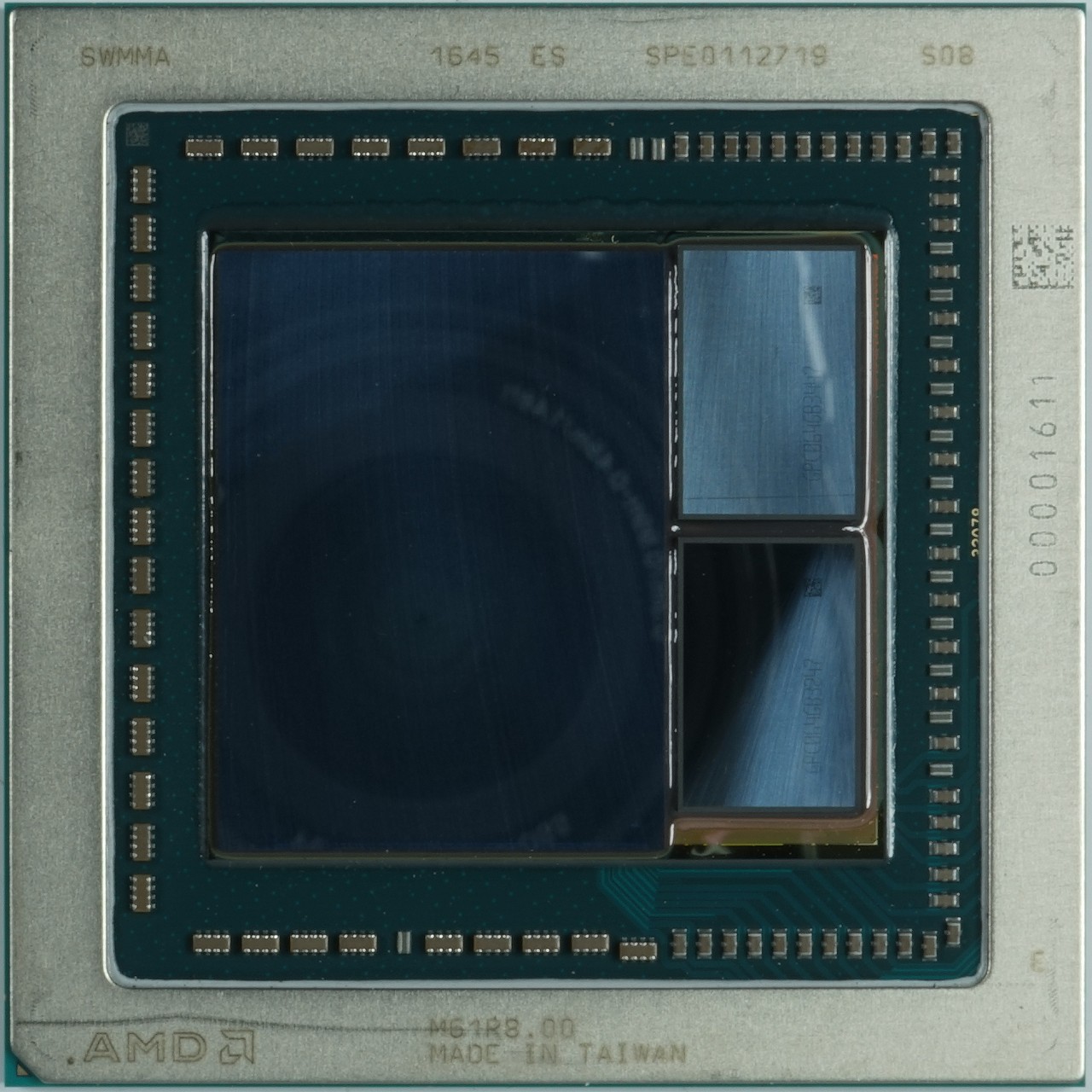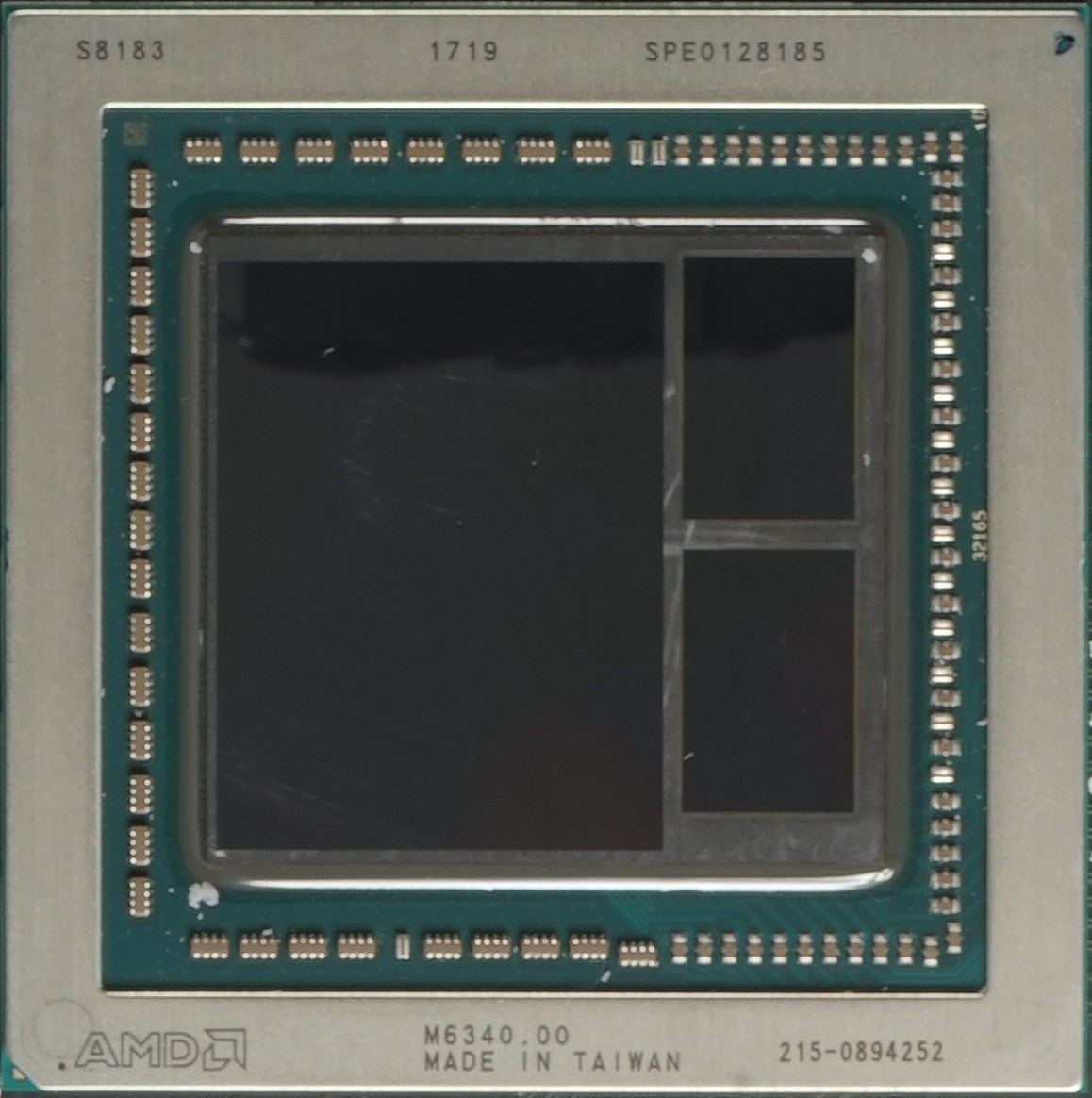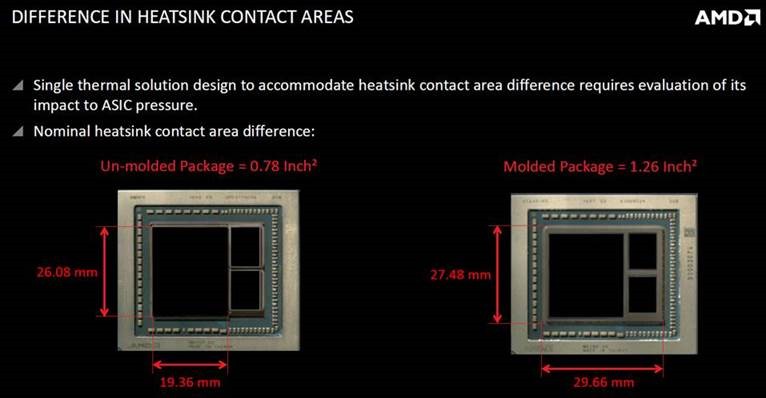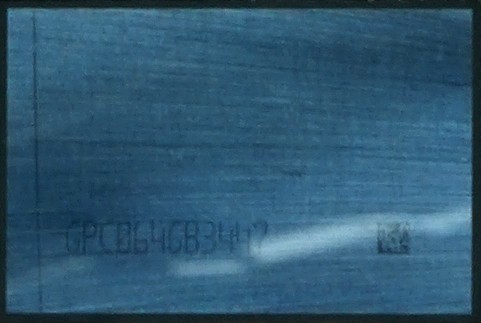Is AMD Vega's Package Construction A Problem? A Closer Look
There's been some confusion floating around about the GPU package construction of AMD's new Vega, in particular surrounding the use of molding and its impact on package height and how this will affect third-party graphics card manufacturers, both in terms of cost and timing. We've talked to several sources, examined various packaging, and conducted a couple of quick experiments in order to provide a clearer picture of these issues.
Let's start with the basics. A GPU (including, in this case, its interposer and complementary HBM2) can’t simply be soldered to the PCB. So specialized manufacturers (ASE in Taiwan, for instance) first create an interface between the semiconductor and board using a flip chip packaging process, which is then much easier to handle in the PCB assembly.
These packages are then fed automatically from a roll to transfer tape, and secured to the PCB using an SMT production line. This can be an issue for very delicate components, since many older SMT facilities are unable to transport and position them without damage.

We’ll start by comparing the package as it was originally presented on AMD's internal PowerPoint slide and demonstrations (pictured above) to the version on our Radeon RX Vega 56 card. We can clearly see that there are deep gaps between the GPU and both memory modules, or, alternatively, that these components are relatively higher.
Conversely, the interposer is extremely thin and fragile. This is likely why AMD warns its partners to be careful when cleaning out thermal paste, as seen below.

The Differences Between AMD's Packages
This can also present challenges to automated processes, particularly when it comes to the issue of underfill (illustrated in the image below), since pressure-sensitive cavities can form between the interposer and intermediate plate during packaging. This can be avoided by adding “molding” to fill the gaps between the chips and memory modules. Here is an image of both variants, with and without molding:

Looking at the Vega Frontier Edition and some Radeon RX Vega cards, pictured below, it's clear that AMD now favors the use of molding. The area around the GPU and memory is filled with an epoxy-like material that significantly improves stability. These packages are made in Taiwan and manufactured by ASE.

A Third Variant Arrives
We've seen both packaging variants, which come from different manufacturers, out in the wild. This can create problems for add-in board partners looking to standardize, of course. But what's this about a third variant? We discovered some differences with our Radeon RX Vega 56 card, including the package's shim, circuit board, and inscription, indicating another manufacturer and origin.

Thinking back to Fiji, AMD usually shipped its chips first to memory vendor SK hynix, which then assembled its HBM modules, had the packages completed in Korea without molding, and finally sent back, completed, to AMD. Both of the Vega cards we tested previously had molded packages from from ASE in Taiwan, so we now have a new Korean package on the scene.
So, What's the Problem?
AIB partners face new challenges, since the HBM2 is about 40 μm lower in the unmolded packages, and the third variant's underfill obviously differs somewhat.
For one, the mass production and use of a common cooler for several models must take the applied heat conducting material into account. The thickness must be optimized for the unmolded packages, the viscosity must be high enough, and the resulting contact pressure can't damage anything after being bolted together.

We tested and compared both PCBs while running the cards with a defined limit so that they received about 260W of power in the same gaming loop. For the thermal paste, we used Diamond from Innovation Cooling, which is somewhat more viscous compared to Thermal Grizzly’s rather thin Kryonaut paste.
To achieve a similar heat curve under load for both packages, we had to apply a slightly higher contact pressure for the lower package (between approx. 0.05 and 0.1Nm more). This could be problematic on some cards; many manufacturers include thread-stops to prevent over-turning, resulting in insufficient pressure when the screws reach their limits.
For Kryonaut’s thinner paste with identical contact pressures, on the other hand, it made no difference which of the two packages we used. It is unfortunate that such thin pastes tend to be unsuitable for use with mass-produced application on the heat sink.

Individual partners now provide thermal solutions with six, rather than four screws. Moreover, all prefabricated heat sinks and backplates for the non-molded packages had to be adapted and thus are no longer usable. Others we've talked to report SMT problems and other adjustments, which could alter the appearance of some custom models.

When asked by its AIB partners, AMD explained that the minimal differences between packages should have no effect on the functionality of previously-developed coolers. Even if this proves true, manufacturers still have to develop their own test cases to prepare for mass production as optimally as possible. And that again costs time, which nobody has. Although the first custom models have been announced for mid-September availability, some models could be delayed until the end of September or early October.
Is it Due to Different Memory?
Right now, it has been suggested that different memory modules (coming from Samsung and SK hynix) are the culprit for all of this. However, this remains purely speculative, as we cannot get a clear statement from any of the involved parties. But it could be one possible reason why we see different HBM2 module heights in the packages, and why there are therefore different production lines.
It is also technically not easy to neatly pour molding for components with widely different heights, which also supports the assumption that different memory modules could be used here. A pure capacity problem in the packaging process can actually be excluded here.
As we were getting ready to publish this, we learned from a reliable source that Radeon RX Vega 56 likely only uses HBM2 from SK hynix. Nevertheless, two package types are also in circulation for Vega 56, which can't be ordered separately by AIBs, allowing them to choose the package type that works best for them. The 0.1mm height difference is by no means negligible.

How Relevant is this, Anyway?
The abilities of each manufacturer are somewhat different. Those equipped with newer production lines have fewer problems making these circuit boards. For the coolers, however, it depends on the specific solution, where potential changes could also mean higher costs. After all, much of what has been planned has to be solved yet again.
On top of that, time is an important factor. Every lost day costs money. If different HBM2 modules come into play, it will be interesting to compare overclocking headroom and thermal performance. Could it be that miners seek out one implementation over the other? We'll be here to figure all of that out.
AMD has said that third-party cards will come at the end of Q3, so we'll have to wait and see whether this impacts the final price and availability of add-in boards, and whether ultimately any of us should care.
Get Tom's Hardware's best news and in-depth reviews, straight to your inbox.
-
NP Q: "How relevant is this, anyway?"Reply
A: "Not relevant, just something random to say in the futile effort to take away the pain from the flopped vega. It looks like a duck, talks like a duck, and walks like a duck. Guess what? It's because it is a duck! Air cooling not enough, but even with huge power draw water cooling wont translate to results, neither in the sense of performance or value. Any TIM spin - or messianic faith in Gigabyte's propeller gadget over AMD's - is just sad. Oh well, better product next time." -
wifiburger The early review showed the HMB frequencies throtling under heavy load that would explain itReply
Huge flaw to their design -
10tacle ReplyAMD has said that third-party cards will come at the end of Q3
Someone leaked some benchmarks of an AIB RX 64, this one being an ASUS STRIX variant. If these benchmarks are true, then AMD better pray that Ethereum doesn't crash (the below is a German website link, so a page translation may be in order):
https://www.computerbase.de/2017-08/asus-radeon-rx-vega-64-vorserie-test/2/#diagramm-performancerating-3840-2160 -
redgarl Ahh please...Reply
You are buying yourself problems... died for a second time in less than 10 months! You are buying yourself problems. Worst card I ever bought!
This review is from: EVGA GeForce GTX 1080 FTW GAMING ACX 3.0, 08G-P4-6286-KR, 8GB GDDR5X, RGB LED, 10CM FAN, 10 Power Phases, Double BIOS, DX12 OSD Support (PXOC)
Pros: -Best Price/Perfomance ratio for any 1080 GTX
-OC easily over 2000 MHz out of the box
-No more cooling required for hitting the 2100 MHz wall of the 1080 GTX
-Incredible customer support from EVGA, 5 stars easily! They paid for both shipping way TWICE with a little convincing.
Cons: -Reliability and Quality Assurance is not there... Don't sugar coat this, it's a bad PCB with many weaknesses
-Overheating of VRAM problems making the card degrade over time until it dies
-A brand new EVGA SuperNOVA power supply blew up with this fantastic 1 month old card
-Nvidia drivers not stable at 4k in windows 10
-Closing or opening a game can make your system crash
-Not as powerful as I was expecting, should have sticked to my dual 290x or waited for a 1080 TI
-Random Displayport and HDMI signal drops when the resolution change in games settings... it's crazy, it's that bad. I cannot say if this is Nvidia drivers or the card, however my IGP never shown any issue with the same cables
Other Thoughts: Update:
My card died for a second time in less than a year. The last time I saw something like that was with a Gigabyte GA-965P. the board died 3 time in 16 months. This is unacceptable and you end up RMA the thing until your warranty is valid. After that, you are on your own. Problems with these cards are going to appear more and more with the time passing as the weak VRAM degrade due to overheating issues and the lack of thermal pad.
I had enough, I ordered a new MSI 1080 TI and I am going to sell my RMA card to an unlucky guy. I am not going to wait for another 3 weeks without a desktop waiting for the replacement.
I learned that my credit card could have covered the cost of the card because newegg refused to take the card back after 30 days. Inform yourself, some cover you up to 90 days. Of course, newegg didn't informed me.
Original:
I bought this card because it was 2 slots only and was providing enough cooling for hitting the 2100 MHz barrier of the 1080 GTX. Buying anything with more cooling power is a waste of time and money since no one can push these cards further. This was the perfect choice.
I woke up one morning and my desktop was shut down. I tried to turn it on but didn't succeed. I suspected a Power Supply failure, however it was the graphic card that died. The card died in idle during the night. Anyway, I was building myself a new mini-itx computer and I decided to test my system with my graphic card. Big mistake, the card exploded and the power supply in my new system was an EVGA SuperNOVA B2 750W. Hard for EVGA to dodge that one. My mobo died also and was perfectly working.
Lessons learned, if your PC doesn't turn on, remove the GPU and test it again.
Also, the new card is showing the same display feed dropping behaviors on a fresh install. It is really annoying and make windows 10 literally crash. In game crashes are rare for me, but jumping in or out of a game is problematic and can make my PC crash due to resolutions conflict issues that are OS or driver related. For those praising Nvidia drivers, I can tell you I never noticed something similar with my 290x AMD cards in crossfire. My system was more stable with my Powercolors CF.
I cannot recommend this product at all. It's an important investment and I am left with a bad experience, I had to RMA from 3 different companies. However, EVGA paid for all the shipping charges even if I am canadian and I received my replacements in less than 3 weeks.
1 egg for product
2 egg for Newegg support (didn't provide any help even if barely 45 days of ownership)
5 egg for EVGA customer support (at least you know they are going to take care of you if something happens) -
InvalidError The RAM doesn't dissipate that much heat and if a manufacturer is that worried about a 40 microns gap, it can always use appropriate thickness foil as a shim.Reply -
techac Seems like you are trying to come with issues that don't exist yet or that there are no complains about.. AMD is selling huge amounts of professional and gaming cards and haven't hear any issues..Reply -
therealduckofdeath I think, a lot of GPU manufacturers automatically voids your warranty if you take off the cooler, so, is this really a big problem? Also, the wording, implying that it's a general problem for anyone buying, is a bit , isn't it?Reply -
knowom a lot of ram doesn't even use heatsink's at all though this is HBM2 and GPU VRAM we are talking about so it's slightly, but even GPU's for the longest while didn't bother using them so take it with a grain of salt I guess on it's overall importanceReply -
robertcainphoto .1 mm equals .0039 inch, close to the diameter of a strand of human hair .Reply
Can't imagine this causing a big problem with thermal heat dissipation.